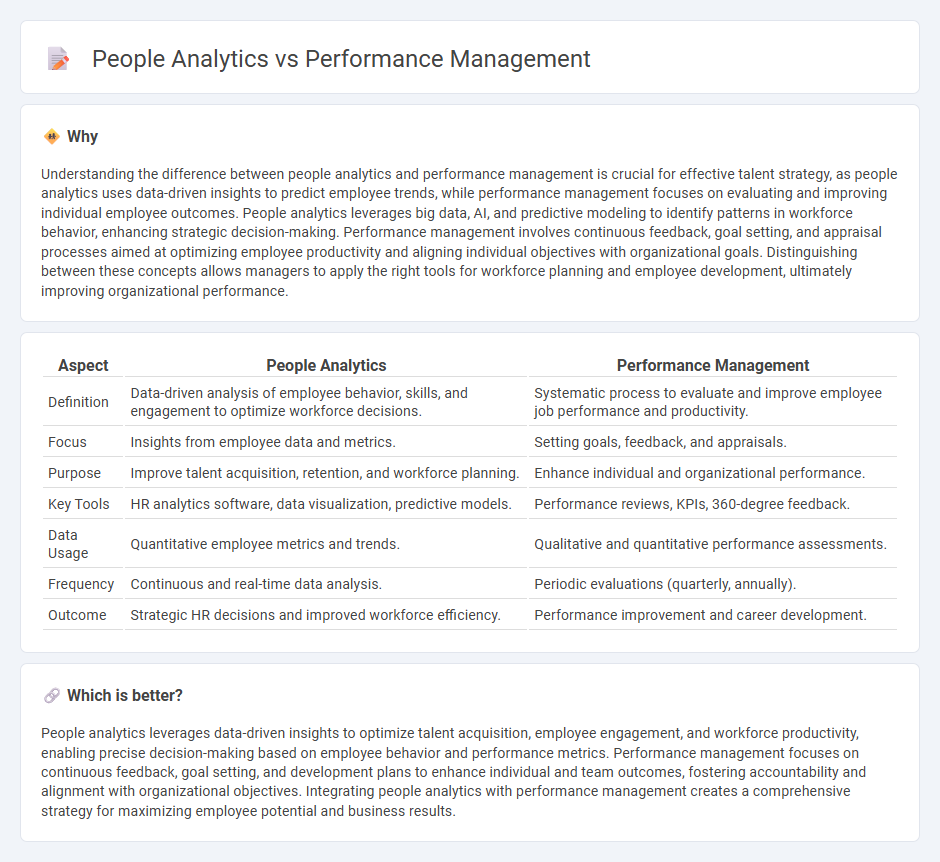
People analytics leverages data-driven insights to understand employee behavior and improve workforce decisions, focusing on metrics like engagement, turnover, and productivity patterns. Performance management emphasizes goal setting, continuous feedback, and appraisal processes to enhance individual and organizational outcomes. Discover how integrating people analytics with performance management can transform your business effectiveness.
Why it is important
Understanding the difference between people analytics and performance management is crucial for effective talent strategy, as people analytics uses data-driven insights to predict employee trends, while performance management focuses on evaluating and improving individual employee outcomes. People analytics leverages big data, AI, and predictive modeling to identify patterns in workforce behavior, enhancing strategic decision-making. Performance management involves continuous feedback, goal setting, and appraisal processes aimed at optimizing employee productivity and aligning individual objectives with organizational goals. Distinguishing between these concepts allows managers to apply the right tools for workforce planning and employee development, ultimately improving organizational performance.
Comparison Table
| Aspect | People Analytics | Performance Management |
|---|---|---|
| Definition | Data-driven analysis of employee behavior, skills, and engagement to optimize workforce decisions. | Systematic process to evaluate and improve employee job performance and productivity. |
| Focus | Insights from employee data and metrics. | Setting goals, feedback, and appraisals. |
| Purpose | Improve talent acquisition, retention, and workforce planning. | Enhance individual and organizational performance. |
| Key Tools | HR analytics software, data visualization, predictive models. | Performance reviews, KPIs, 360-degree feedback. |
| Data Usage | Quantitative employee metrics and trends. | Qualitative and quantitative performance assessments. |
| Frequency | Continuous and real-time data analysis. | Periodic evaluations (quarterly, annually). |
| Outcome | Strategic HR decisions and improved workforce efficiency. | Performance improvement and career development. |
Which is better?
People analytics leverages data-driven insights to optimize talent acquisition, employee engagement, and workforce productivity, enabling precise decision-making based on employee behavior and performance metrics. Performance management focuses on continuous feedback, goal setting, and development plans to enhance individual and team outcomes, fostering accountability and alignment with organizational objectives. Integrating people analytics with performance management creates a comprehensive strategy for maximizing employee potential and business results.
Connection
People analytics leverages data-driven insights to enhance performance management by identifying employee strengths, weaknesses, and engagement levels. Integrating real-time analytics allows managers to set personalized goals, track progress accurately, and make informed decisions that boost productivity. This connection fosters a strategic approach to talent development and organizational effectiveness.
Key Terms
Key Performance Indicators (KPIs)
Performance management centers on setting and evaluating Key Performance Indicators (KPIs) to monitor employee productivity and align individual goals with organizational objectives. People analytics leverages data from KPIs to uncover trends, predict outcomes, and enhance decision-making by integrating workforce insights with business strategies. Explore the full potential of combining performance management and people analytics to boost organizational effectiveness.
Data-Driven Decision Making
Performance management relies on tracking employee goals, productivity metrics, and feedback cycles to enhance workforce efficiency. People analytics leverages big data, AI, and predictive modeling to uncover patterns in employee behavior, engagement, and retention for strategic talent decisions. Explore the synergy between these approaches for more effective data-driven decision making.
Employee Engagement
Performance management leverages systematic evaluations and feedback to enhance employee productivity and align goals, while people analytics uses data-driven insights to understand workforce behaviors and improve employee engagement. Focusing on employee engagement, people analytics identifies key drivers such as job satisfaction, work environment, and recognition patterns, enabling targeted interventions. Explore how integrating performance management with people analytics can transform employee engagement strategies and boost organizational success.
Source and External Links
What Is Performance Management? The Complete Guide - AIHR - Performance management is an ongoing process where managers and employees regularly communicate to assess, review, and align job responsibilities and goals, utilizing methods like SMART goal setting and continuous feedback to foster growth and maximize organizational performance.
What is performance management? HR guide - Culture Amp - Performance management involves managers providing feedback to employees to ensure their performance matches organizational objectives, encompassing both retrospective measurement and forward-looking development to support continual growth and engagement.
Performance Management - KU's Human Resources - It is a continuous process of clarifying roles, setting aligned goals, conducting regular feedback sessions, and reviewing outcomes to optimize individual performance in line with organizational strategy.
 dowidth.com
dowidth.com